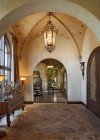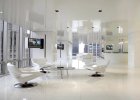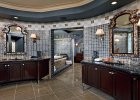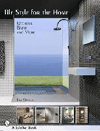
Stone
and tile remain key components in many interior designs
today.
The entry of this private residence in Austin,
TX,
which
exhibits an extensive stone palette, features a groin vault
ceiling
made of Giallo travertine with a rock-face fi nish complemented
by
Foundry Masters 4-inch decos and Café Noir
travertine
corbels and groin ribs. A stone “rug” was created as
a
point of interest on the fl oor. Architect:
James D. LaRue Architects,
Austin,
TX; Designer:
John-William Interiors, Austin,
TX;
Builder: Pat
Heyl; Stone Supplier: Materials
Marketing,
Austin,
TX
When using stone and tile in an interior space, architects and designers are putting more thought into the way these materials can influence other components of a design. They are taking into consideration the furniture, lighting and other aspects within a space, and designing based on how tile and stone can enhance the overall area.
In a corporate setting, a floor pattern may reflect the structure of a ceiling or complement desk areas and other office furnishings -- creating refreshing and innovative spaces for tenants and visitors. Moreover, certain tile or stone products with a polished or reflective finish have the ability to create depth and, as a result, are ideal for applications such as making a low-ceiling space appear larger.
For residential interior designs, stone and tile can bring together a feature area of a living space or even an entire quarter. James LaRue of James D. LaRue Architects in Austin, TX, explained that he prefers using natural stone and tile as opposed to other materials -- especially on the floor -- when designing. “It’s easier to decorate with and more interesting,” he said. “The patterns are better, and we can cut it the way we want. The design possibilities are endless.”
And in addition to the floor, the architect believes that continuing these materials onto other areas of a residential space can benefit the design. “We like to bring them onto the hearths, mantles, countertops and so on,” he said. “It really ties a home together.”

A
floor-to-ceiling stone fireplace and large stone
archway
are a focal point of the home’s dining room.
An Extensive Use of Stone
LaRue recently completed the design of a “Parade of Homes” residence in Austin, TX, where the use of natural stone was extensive. The project, which served as a speculative home, was one of seven residences on the tour that was ultimately purchased. It sits on a hillside with a “Texas view” and lends itself to a Southern European influence, according to LaRue.“The living spaces -- including the kitchen, areas of the ceiling and flooring -- feature stone tile,” he said. “There are also large stone walls in the interior that really create that warm European feel.”

A
highlight of the master bathroom is the tub with a
built-in
fireplace. Giallo travertine was used for the
fireplace, while 8- x 8-inch Gold Sand Classic travertine
tiles
with Los Clavos Bronze Rosettes surround it.
“We were trying to make this project an authentic Tuscan villa,” said Interior Designer Babs McMaude, ASID, TBAE of John-William Interiors in Austin, TX, which served as the designer for the project. She was quick to acknowledge the efforts brought forth by the architect and her team member, Interior Designer David Bravo, Allied ASID. “This was a collaboration,” she said. Some of the feature areas of the home’s interior include the foyer, library, kitchen, recreation room and master bathroom.
For the foyer floor, McMaude went with a stone “rug” design that included Foundry Masters metal 4-inch decos, 4- x 8-inch pieces of Giallo travertine with a French quarter finish, 5- x 8-inch panels of Giallo Royale in a mosaic pattern and 16- x 16-inch pieces of Walnut travertine. The border of the stone “rug” consists of 24- x 24-inch tiles of Walnut travertine, while the same material in 4- x 8-inch pieces was employed for the thresholds. All of the Walnut travertine in the home features a “French Quarter” finish, which the designer described as “beyond tumbled” in terms of texture.

The
Austin home
also includes a recreation room with
a
feature wall made of a limestone mixture and a
granite
bartop.
In the kitchen, hand-carved Sienna limestone is found in the entryway, and it also frames the stove. The floor in this space is comprised of Walnut travertine. Copper Canyon granite countertops complete the look of the room.
For the master bathroom, McMaude created a pinwheel floor pattern of 4- x 8-inch Walnut travertine and 4- x 4-inch Giallo travertine. The highlight of this space, however, is the tub with a built-in fireplace made of Giallo travertine surrounded by 8- x 8-inch Gold Sand Classic travertine tiles with Los Clavos bronze Rosettes.

For a private residence in the Olympic Towers, which
sits in the center of Manhattan, a major goal was to
preserve and enhance the views, while also maintaining
a visually clean space. White quartz was selected
to carry out this objective. Architect: Turett
Collaborative Architects, New York, NY;
Designer:
Christopher Coleman Interior Design, Brooklyn, NY;
Stone Supplier: Architectural
Systems, Inc., New
York, NY

In total, 3,400 square
feet of floor space utilizes 24- x 24-inch pieces of
White quartz.
A Minimalist Approach
Stone was also the primary component for a private residence in the Olympic Tower, which is in the middle of Manhattan. A major goal for the upscale residential interior was to preserve and enhance the views, while also maintaining a visually clean space.“The residence sits on the 39th floor with east, west and south views, so we didn’t want a lot of distractions within the space,” said Wayne Turett, Principal Architect of Turett Collaborative Architects in New York, NY, which served as the architect for the project.
To achieve these objectives, Turett and the design team selected 24- x 24-inch pieces of White quartz from Architectural Systems, Inc. of New York, NY, for the entire floor of the 3,400-square-foot space. “We didn’t want a lot of patterning,” he said. “We wanted a monolithic floor, which the White quartz provided.” The White quartz also possesses a reflective feature, according to Turett, which was a desirable characteristic for this particular space. “We considered a white stained wood instead of the stone floor, but the reflectivity in the White quartz tended to open up what was not considered a high ceiling space,” he said.
Since the quartz floor flows into all areas of the residence, including the bathroom, the architect explained that the tile there had to be honed in this area. “It’s kind of a slippery material,” said Turett. “So in the bathrooms, we honed it. Sealing the honing was difficult, but we were successful in the final result.”
The final outcome of the entire project was well received. “This project was very detail oriented, so a lot of care went into it,” he said. “The client loves the space. They were involved in the selection process as well, and this is exactly what they were looking for.”

For the master bathroom of a private residence in
McLean, VA, the design concept was to organize a succession of spaces that fl
ow from a semi-circle vanity area to a
bathroom that features a water closet, a borderless tub
with ceiling-fed water, a steam shower and two linen closets. Glass mosaic
tiles from Oceanside Glasstile, which
were distributed through Architectural Ceramics, helped
realize this concept. Designer: Interior Concepts, Annapolis,
MD; Tile
Designer and Installer: Holland Tile
Premier Installers, Baltimore,
MD; Tile
Manufacturer: Oceanside Glasstile, Carlsbad, CA; Tile
Distributor: Architectural Ceramics, Baltimore, MD
Smooth Transitions with Tile
For the master bathroom of a private residence in McLean, VA, the design concept was to organize a succession of spaces that flow from a semi-circle vanity area to a bathroom that features a water closet, a borderless tub with ceiling-fed water, a steam shower and two linen closets. Glass mosaic tiles from Oceanside Glasstile of Carlsbad, CA -- distributed through Architectural Ceramics of Rockville, MD -- helped realize this concept.Although the design team from Interior Concepts Inc. of Annapolis, MD, began with 16- x 16-inch pieces of honed Lagos Blue limestone to cover the floor area, tile was the main focus of the design, according to Davis Holland Leichsenring of Holland Tile Premier Installers, which served as the tile designer and installer for the project. “Glass tile and mosaics, featuring 17 different colors and shapes, covered every facet of the bathroom,” he said, adding that he was involved with converting the initial concept to the final layout.
In total, the bathroom utilizes 1,100 square feet of glass mosaic tiles, which Leichsenring explained posed some unusual constraints within the installation. “Although the nominal sizes were intended to match, the actual dimensions did not align,” he said. “Additionally, the door jambs required strict tolerances for the frameless glass doors, which in turn required the handmade radius tiles to be perfectly plumb, flat and square. Because the handmade tiles varied so much, many of them had to be grinded, smoothed, cut or sanded then re-polished to provide the perfect look once installed and grouted.”
These concerns were addressed by removing the paper-face mosaics and remounting them to match the desired grout grid, according to Leichsenring. His team also decided to build up and cure the substrate behind the radius jamb tiles prior to the tile positioning. Flexible caulking was additionally applied before grouting for a true expansion joint, he explained.
“The result was an impeccable tile installation crafted to match the exquisite quality of the fixtures, cabinetry, furniture and decor,” said Leichsenring. “Every facet of this project was executed with a level of necessary creativity to bring all these unusual elements together for a beautiful bath to last a lifetime.”

Inside the CVC Capital Partners’ (CVC) New York City corporate office limestone
is used in the reception and elevator area to create an
inviting and attractive
design. Designer:
MKDA, New York, NY;
Stone Supplier: Stone Source, New
York, NY
An Inviting Work Environment
Even in a corporate setting, the environment must possess synchronization, which stone or tile can help accomplish. When CVC Capital Partners’ (CVC), a leading global private equity and investment advisory firm headquartered in Luxembourg, opened its first North American corporate office, the focus was to design an inviting and attractive space. “People spend a lot of time in the office, so it should be very appealing,” said Daniel DeSiena, Senior Vice President and Director of Design for MKDA of New York, NY, the design firm for the project.The welcoming effect of the office, which is located in New York City, can immediately be found in the entrance areas, which feature limestone from Stone Source of New York, NY. The design team selected 16- x 16-inch pieces of St. Croix limestone for the floor areas of the elevator and reception region that totals 800 square feet of space. “The St. Croix is a fairly monolithic and warm, creamy color,” said DeSiena. “We wanted it to be warm.”
According to DeSiena, the selected material produced harmony with other components of the entrance space, such as the reception desk and additional woodwork features. “This created a very modern feel because of the counterpoint of light and dark,” he said. “Overall, it made for a warm and appealing work environment.”
In the elevator area, an inset band border of 12-inch-wide Avoria limestone pieces accompanies the St. Croix limestone, serving as an accent feature. “This limestone reflects the ceiling lighting fixtures overhead,” the designer explained, adding that it was a challenge laying out the inset bands in relationship to the ceiling and the walls.
Additional challenges came with blending in the stone material used. “I looked at the pieces with the installer when they were taken out of the box,” he said. “As with all stone projects, we wanted the stonework to blend in so that the floor has a monolithic look. We were completely positive to the installation.”
Prior to the installation, DeSiena and his team had also gone with the client to hand pick the material that would be used for the project. “The client was highly involved in many aspects of the design,” he said. “We went to the stone yard so the client could see the material in person. That’s not always done, but this client was involved.”
In the end, all those involved with the project were pleased. “The New York director loves the space,” said DiSiena. “The European partners came over and were very pleased as well. The materials are rich, but it’s nothing ostentatious.”

